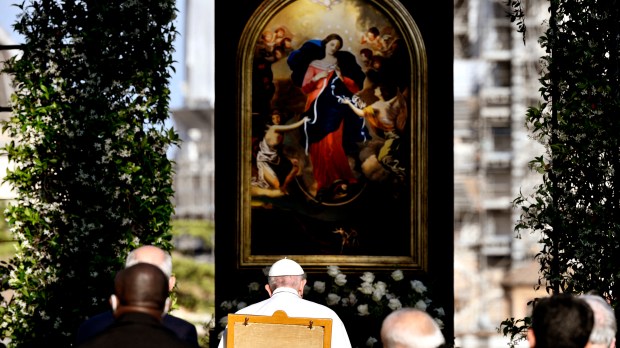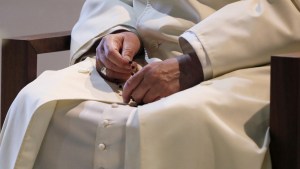“A shroud has no pockets,” Jorge Mario Bergoglio’s grandmother once told her grandson — meaning you don’t take anything with you to the afterlife. It’s a statement that has stayed with the Pontiff ever since, as he has tried to avoid becoming too attached to material possessions. But certain objects do have spiritual importance for him, such that he makes a point of always keeping them close to him. In his new biography Life: My story through History (Harper Collins, March 20, 2024), the Pope reveals to us the small devotions he is particularly fond of.
Statues of St. Joseph
Pope Francis always keeps a statue of sleeping St. Joseph close to his bedside table. He has had it ever since he was provincial of the Jesuits in Argentina (1976-1979). Since then, he has made a habit of “slipping notes under it from time to time, on which he writes down the difficult situations he has to overcome.”
The Pope’s devotion to the earthly father of Jesus is very strong. This is evidenced by his attachment to another statue of Joseph, this time standing upright and holding the Child in his arms. He prays before this statue every day in the early afternoon.
His medal of the Virgin Mary
Pope Francis wears a medal of Our Lady around his neck. It was given to him by Concepción Maria Minuto, a woman of Sicilian origin who used to help his mother twice a week with the washing by hand. The Pontiff remembers her as a simple, courageous woman.
Years later, the woman tried to contact him, but Fr. Bergoglio was busy and turned her down. He felt guilty about it later, but was able to see her one last time just before her death, assisting her in her last hours on earth. “I often think of her, every time I look at the medal she gave me, and I pray for her,” he says.
His prayer corner
“On a shelf in his room sits a statuette of St. Francis of Assisi, an image of St. Thérèse of Lisieux, to whom he is devoted, and a large crucifix before which he prays every day, one hand resting against the wall.”
From the first of these, the Argentine Pope borrowed his name in 2013, responding to Cardinal Hummes’ appeal not to forget the poor. On October 15, 2023, the Pope dedicated an apostolic exhortation, C’est la confiance (“It is confidence”), to mark the 150th anniversary of St. Thérèse’s birth.
Another important devotion, the fruit of daily prayer, is that which links him to the “Mary, Undoer of Knots.” The Pontiff became devoted to this Baroque painting of Our Lady during his visit to Germany in 1986. Although he was never able to visit the original, located in a former Jesuit church in Augsburg, he had a copy of the painting hung in the reception room of the Vatican’s Santa Marta residence, where he lives and often receives visitors.
The “treasure” of his breviary
The Pontiff is absolutely “inseparable” from his breviary, the book containing the Liturgy of the Hours, the prayer of the Church. Inside it, he treasures three texts. The first is a letter written half in Italian and half in Spanish by his grandmother Rosa on the occasion of his ordination in 1967.
“On this wonderful day, when you can hold Christ the Savior in your consecrated hands, and when a long road to the deepest apostolate opens up for you, I offer you this modest gift of little material value but immense spiritual value,” she says in her letter. The gift in question is a kit for the anointing of the sick.
The Pope also keeps in his breviary Rosa’s “testament” (she died in 1974). In it, she tells her grandchildren,
“If one day pain, illness, or the loss of a loved one should fill you with affliction, always remember that a sigh at the tabernacle, where the greatest and most august martyr is preserved, and a glance at Mary at the foot of the Cross, can apply a drop of balm to the deepest and most painful wounds.”
Lastly, the Pope keeps in his breviary a poem by the poet Nino Costa, Rassa Nostran-a, a text that reminds him of his roots. This text pays tribute to the poor Piedmontese who go off to work outside Italy, that “indigenous, free, and stubborn race” to which his father belonged, who lived in the small town of Portacomaro before moving to Argentina.


